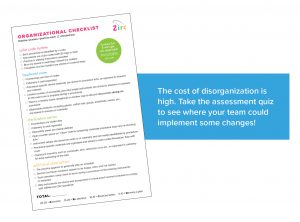Working Short-Staffed?
Strategies to Reduce Stress and Stay Productive
By Kay Hickey, LDA and Clinical Efficiency Consultant
Imagine getting to work at the dental practice to discover your co-worker called in sick. You might feel bad that they are sick, but then it hits you: you are working short-staffed today. You immediately look at the schedule and see it is heavily booked. As a former dental assistant, I can still remember that feeling of my sinking heart and rising anxiety. It’s going to be a tough day. I would quickly try to recover and put myself in “just get me through this day” mode. Now imagine coming into this kind of environment every day, maybe for weeks or even months! Many of you are dealing with just that, and you are in good company. There is a significant shortage of dental professionals, including assistants, hygienists, office administrators, and dentists!
According to a June 9th, 2021, ADA News article, 35% of dentists are looking for assistants, 28% need hygienists, and 26% want administrators. Of those dentists, 80% are finding the recruitment process extremely challenging. During an October 11th, 2021, podcast hosted by Dental Economics, Next Level Practice consultant and founder, Dr. Gari Kadi, stated, “Since the pandemic, dentistry lost over 10% of its workforce.”
I am an efficiency consultant with Zirc Dental Products, Inc., where we manufacture products to help dental practices become safer, happier, and more efficient. I work with practices daily, and one of the biggest concerns I hear is the difficulty they are experiencing while having to work short-staffed. This was an issue well before COVID-19, but the pandemic certainly exasperated the problem.
Emotional and Financial Stress
The following stressors from working short-staffed can cause burnout, lost revenue, and frustrated teams and patients.
• Running behind schedule
• Decreased production
• Continuous training (Temps, subs, family members, cross training team members)
• Inefficient inventory management
• Increased cost of supplies
• Missing items at chairside
• Poor patient perception
• Stressed, unhappy team
• Non-compliancy (OSHA and maintenance schedules)
• Increased employee turnover
• Salaries increased and employees working overtime
The good news is, there are some strategies to maintain production while we are working short-handed. Bonus! Once you have a complete team back in place, these strategies will make you even more productive than you were before!
At Pure Health Dental we use the color-coded B-Lok instrument trays and procedure tubs by Zirc to
organize our clinical chairside setups. Zirc’s Color Method system has improved our time management and increased our efficiency with organization. The array of color looks way more professional in front of the patients and especially our providers. The B-Lok Tray System also helps with infection control and allows our providers to have all of the necessary instruments and adjuncts at their fingertips! When interviewing and hiring providers (hygienists and dentists), I show them this color-coding process and their eyes literally light up! This impresses them more than the technology we offer.”
AZIZA ABED • V.P. OF ENTERPRISE TRANSFORMATION, GREAT EXPRESSIONS
Tips and Tricks to Get Through the Day
1. Morning huddle: Be sure that the entire team is present for a morning huddle. Spend fifteen minutes at the beginning of the day to check in with each other and see how everybody
is doing. During this time, you will review the schedule from the day before and see if there were any hiccups. A quick discussion will prevent those same pain-points from happening repeatedly. Review the day’s schedule and look for potential bottlenecks. Discuss the best place to add in
emergency patients.
2. Re-evaluate procedure times: Track how long it takes from setup to tear-down of a procedure when you are working short-staffed to estimate accurate appointment times. Track the times for at least one week and figure out the average time spent. You may need to consider temporarily adding in a little extra time into each procedure. I understand we don’t like to do this, but it may be necessary to prevent patients and/or employees from leaving.
3. Cross-train: For example, in a pinch, assistants should be able to schedule appointments and answer phones, just like administrators should know how to get a treatment room set up and reprocess instruments. When we are missing team members, we must have each other’s backs!
4. Evaluate your clinical systems: Do you find that you: must go to multiple areas to find what is needed for a procedure? Can’t quickly locate what is needed? Are finding an abundance of expired materials? Perhaps you are running behind schedule or working late to get caught up. If so, it is
time to consider making some changes. Zirc’s Color Method is a simple color code system that identifies each procedure with a different color for quick and accessible material and instrument management. The Color Method has been proven to save time and money, increase efficiency, and create a stress-free, cohesive environment. It can be implemented in five easy steps:
• Get colorful: Assign each procedure a different color.
• Instrument management: Utilize cassettes, bur organizers, and procedure trays with locking covers to keep everything together and organized from setup to sterilization.
• Material management: Procedure tubs become portable drawers for procedure specific materials. Tubs will reduce: the amount of inventory on hand, missing materials at chairside, and lost or expired materials.
• Sterilization Center: Make it the hub of the practice. Store tubs with materials, trays with the instrument set-ups, and extra inventory for tub restocking. Simply grab a blue tray and a blue tub, and you will have everything needed for the procedure. I call that “grab and go organization”!
• Treatment rooms: Countertops should be free of clutter. Utilize the drawers or cabinets to store disposables such as cotton products, gloves, saliva ejectors, etc.
Working short-staffed doesn’t mean that our days must bechaotic or unproductive! Implement some strategies that will provide a sense of calm as we weather out the storm. Sometimes challenging times is what is needed to force us to make improvements in our work practices. The team can be happier and more productive whether working short-handed, or not.

